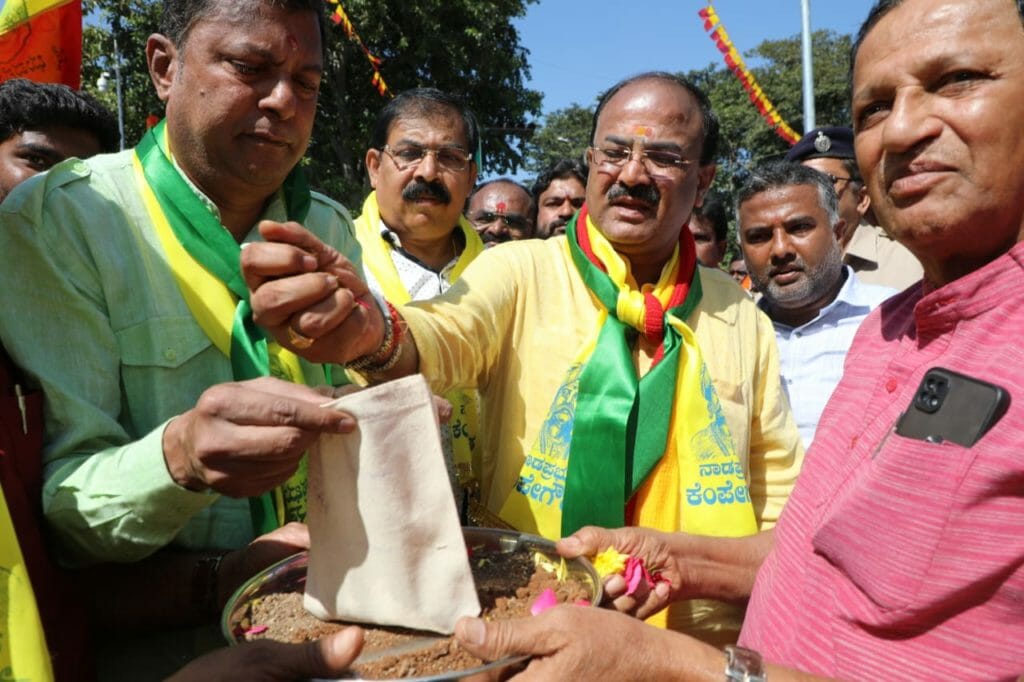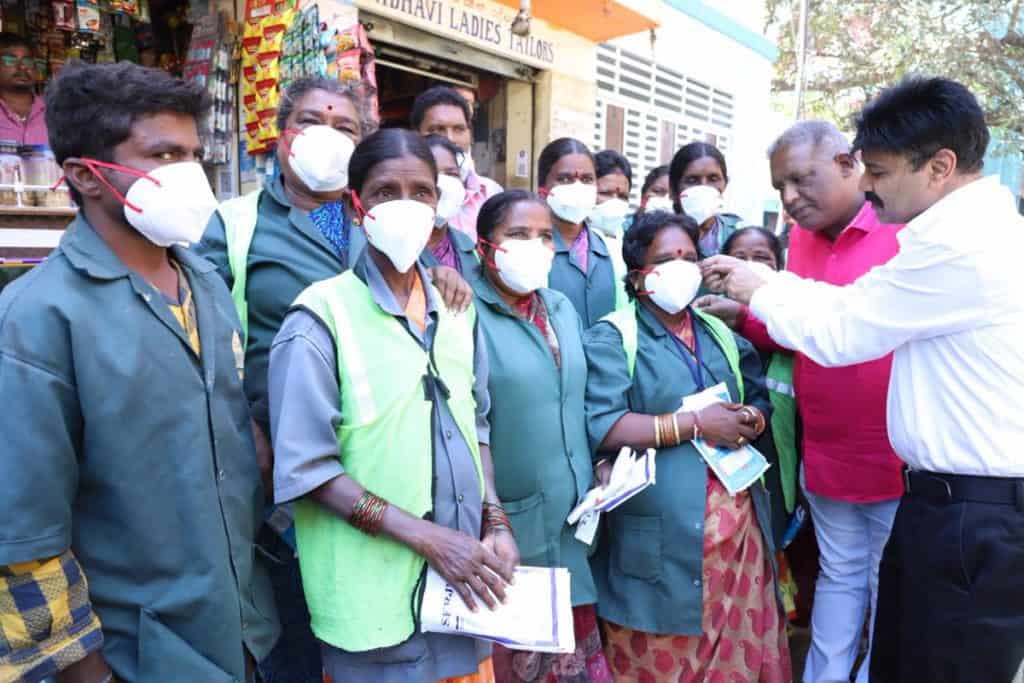Statue of Prosperity to be unveiled
The 108-feet bronze statue of Kempegowda, the founder of Bengaluru, will be unveiled at the Bengaluru International Airport, Devanahalli, by Prime Minister Narendra Modi on November 11th.
It will be called the ‘Statue of Prosperity‘ to symbolise the progress of the city under the vision of its founder, Kempegowda. On October 21th, as part of the Nadaprabhu Kempegowda Campaign, vehicles were flagged off from Vidhan Soudha’s grand steps to collect sacred soil and water from the 31 districts of the state. The sacred soil and water will be integrated with the Kempegowda Theme Park at KIA from November 7th.

PM Modi will also inaugurate the much-awaited Terminal 2 of the airport.
Source: The Hindu, The Indian Express
Read more: How did bygone Bengaluru celebrate Deepavali? A citizen recounts
Firecrackers lead to injuries and pollution
At least 16 cases of injuries caused by firecrackers have been registered in government and private hospitals. The state-run Minto Ophthalmic hospital had already set aside 30 beds for patients with firecracker injuries. This time, the hospital admitted 13 cases, including facial burn and eye injuries. Although the injured were mostly bystanders, it also included children and even a 45-year-old woman.
Air and noise pollution shot up on Tuesday (October 25th) during Deepavali night. The CPCB (Central Pollution Control Board) revealed that in Jayanagar, Silk Board and Bapujinagar, the level of PM2.5 was between 414 and 500 micrograms between 9 pm and 12 am, while it was at 400 micrograms/cubic metre in Hebbal.
The average PM10 in Jayanagar rose from 39 micrograms per cubic metre on October 17th to 136 on October 24th. It shot up from 49 to 113 in Hebbal and 51 to 140 at Silk Board. The PM10 count could be labelled ‘severe’ (377 micrograms per cubic metre) at all three stations. The worst AQI (air quality index) was at Silk Board, at 320 points and Karnataka Vidyuth Karkhane station at 312 points.
Experts said that the major reason for the pollution was the bursting of crackers.
Source: The Indian Express, Deccan Herald
Government advisory on COVID-19 prevention
On Tuesday, the Karnataka health department issued an advisory, after the state TAC (Technical Advisory Committee) on COVID-19 met on October 19th to discuss measures needed to be taken to fight the new sub-variants of Omicron, BQ.1, BA.2.3.20 apart from XBB, which are spreading in nearby states and are risky due to the festive season.
Patients suffering from fever, cough, cold, sore throat and breathing problems need to get tested at the nearest health centres and self-isolate. Protection with N-95 medical masks are compulsory for patients indoors, or in air-conditioned, closed and crowded places. It was also said that it would be better to observe festivities outdoors and avoid crowding indoors.
The health department has asked people to get vaccinated and take boosters, especially those who are aged 60 and above, and those with co-morbidities. Those who are immunodeficient and immunocompromised, on renal dialysis, and taking anticancer drugs are advised to get vaccinated on priority.

They should follow COVID-appropriate behaviour, such as coughing and sneezing into folded elbows, using tissues and handkerchiefs, not blowing their noses or spitting in public areas, hand washing and avoiding close contact with symptomatics.
The TAC noted that the daily testing numbers of COVID-19 cases in Bengaluru, which has always been the centre of the pandemic in the state, has dropped to around 2,500. This should be increased to at least 10,000.
Source: The Indian Express, The Hindu
Read More: Caste pervades every aspect of life in Bengaluru: Panel discussion
Ordinance to increase SC/ST quota
Karnataka governor Thawarchand Gehlot has green signalled the state’s ordinance to increase the quota of the SC (Scheduled Caste) and the ST (Scheduled Tribe) communities in jobs and education. It would increase the quota for SCs from 15% to 17%, and for STs from 3% to 7%. The additional quota would push up the reservation to 56%.
The ordinance is based on the recommendations of the Justice Nagamohan Das Commission, but will also be tabled in both Houses of the Karnataka Legislature for discussion and approval.
Source: The Indian Express
Garbage collection rules
After numerous negotiations with contractors and NGOs, the BBMP redesigned rules for collection and transportation (C&T) of waste. Now, garbage contractors will be collecting garbage, while waste pickers will manage DWCCs (dry waste collection centres).
Wet waste will be collected, via a vehicle, from households only for five days. The same vehicle will collect dry waste for the next two days. Sanitary waste will be collected everyday, but NGOs or waste pickers will no longer be responsible for collecting it.
The BBMP has mandated contractors to send dry waste to DWCCs, managed by the waste pickers, but without support from the BBMP, so that they are self-sustaining. Earlier, 25% of the dry waste was sent to DWCCs, but the rules have been changed after going through feedback.
The BBMP has also relaxed tender conditions and has permitted lead bidders with experience to provide primary and secondary waste collection. The bidders can partner with any firm for the task.
The collection of waste across 243 wards has been divided into 89 packages. The collection is expected to be done from 42 lakh households, costing around Rs 590 crore a year, an increase of Rs 90 crore. Each DWCC is expected to offer incomes to 10 to 15 rag pickers, besides ensuring segregation of dry waste.
Source: Deccan Herald
Busting myths around solar eclipse
On October 25 (Tuesday), during the partial solar eclipse (at a percentage of 10%) from 5.12 p.m. to 6.27 p.m., Anti-Superstition Federation activists, gathered on the steps of Town Hall, and tried to bust myths around solar eclipse. They distributed various foods, including sweets, for passers-by in order to create awareness against superstitions. However, streets were deserted and several temples opened up only after the eclipse was over and after the premises were cleaned.
Jawaharlal Nehru Planetarium, along with Bangalore Association for Science Education, organised a panel discussion and live-streamed video footage of the partial eclipse from different parts of the world. The interactive discussion included experts answering many questions.
Source: The Hindu
[Compiled by Revathi Siva Kumar]